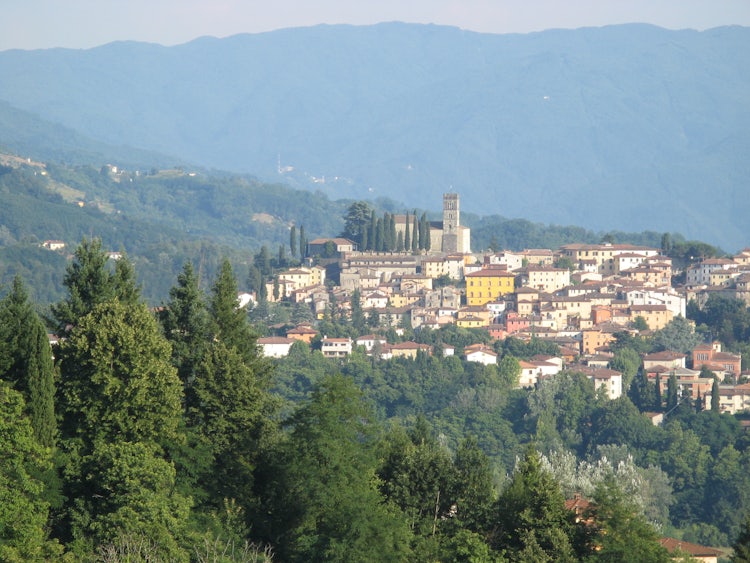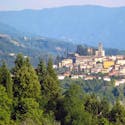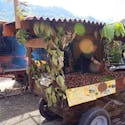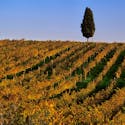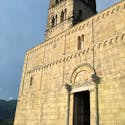Discover Castles, Medieval Bridges & Ghost Stories
Add something a bit different to your driving itinerary in Tuscany and indulge in a one day trip outside of Lucca into the green valleys and lofty peaks of the Garfagnana, characterized by small towns harboring imposing fortresses, stories of fierce battles and local recipes that will tantalize your taste buds.
Starting from the south of Garfagnana, just outside of Lucca, this itinerary works its way up to the border of the Lunigiana area of Tuscany. The selected points of interest in highlight towns with historic monuments, traditional restaurants, and stunning photo opportunities.
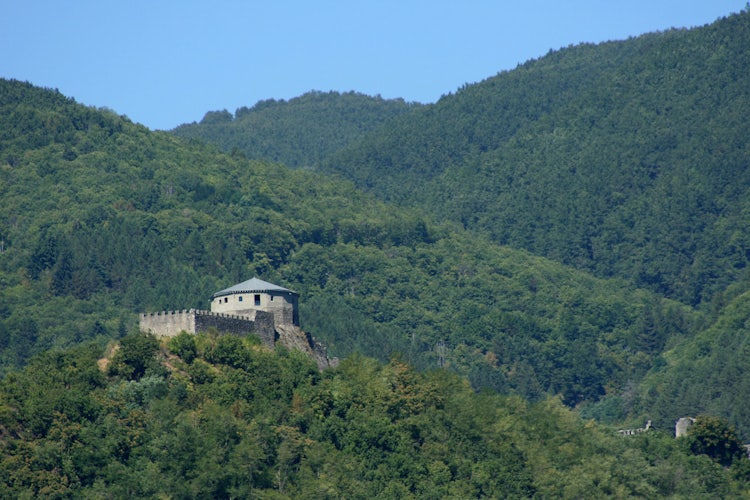
Itinerary Facts
Driving time: 3 hours and 25 minutes
this time includes no stops or the detour indicated below
When to Visit: All year. Roads are well maintained
Starting/Ending Point: Lucca
Highlights include: Borgo Mozzano, Gallicano, Castelnuovo Garfagnana, Piazza del Serchio, Castello Della Verrucola (optional detour: Grotta del Vento, Eremo di Calomini, Vergemoli [add 1 hour &10 min to your time]),
We aren’t suggesting that you stop in all or any of these places to appreciate the beauty of the Garfagnana. You can just do a drive-by, or simply pick out the one that intrigues you the most. The stunning landscape and the towns set the stage for an adventure that can easily be enjoyed from the car as you cover the miles at a leisurely pace.
The entire area of Garfagnana was marked by a never-ending rivalry between the local ruling powers. They were constantly establishing borders, governments, and cities, only to tear them all down again and start a new. But perhaps it is this very turbulent history that leaves us with a large number of small towns to visit, each with castles or fortresses and a tradition that translates into local culinary specialties and warm hospitality.
Borgo Mozzano
The first point of interest focuses on the Ponte della Maddalena, perhaps better known as "Ponte al Diavolo", a stunning example of medieval architecture. This stone bridge spans the river Serchio and once served as a fundamental crossing for pilgrims on the via Francigena. This medieval trail covers Tuscany starting in Pontremoli down to Radiocofani.
Believed to have been built around the year 1080 -1100, the central arch reaches 18 meters above and seems to tease gravity. The original bridge had only three arches, the fourth arch that we see today spanning the new roadway may take away from the aesthetic beauty but it was necessary for the stability of the bridge while adding more effective transit routes.
Coming up from Lucca you will want to follow the SP12 which will take you straight to the bridge, where you will find plenty of free parking while you walk around and take photos. Be prepared it is steep!
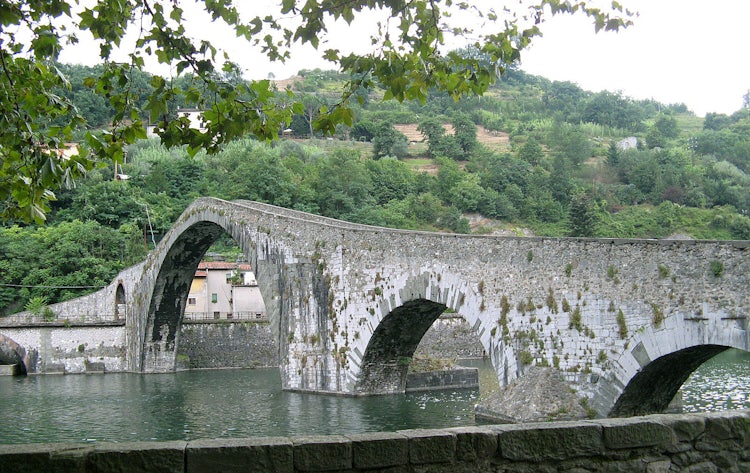
Gallicano
Documented in the archives of the Archbishop in the year 771, this little town with its castle may even be a remnant of a Roman fortress, named after a Roman soldier "Cornelio Gallicano". However what we see today, with the defensive walls and the Romanesque style church, is definitely from the feudal era. It was later transformed into a fortress and it appears that it was surrounded by a second protective wall which boasted 11 towers.
If you are in the area around the 25th of July, then make plans to stop and participate in the traditional “Palio di San Jacopo”, in honor of the Patron Saint. In particular, you don't miss the parade of papier-mâché floats. If you are looking for a sit-down meal, Trattoria al Ritrovo del Platano (Via Ponte di Campia, 11/a, 55027 Gallicano LU) comes highly recommended by the locals for traditional flavors valorizing genuine recipes.
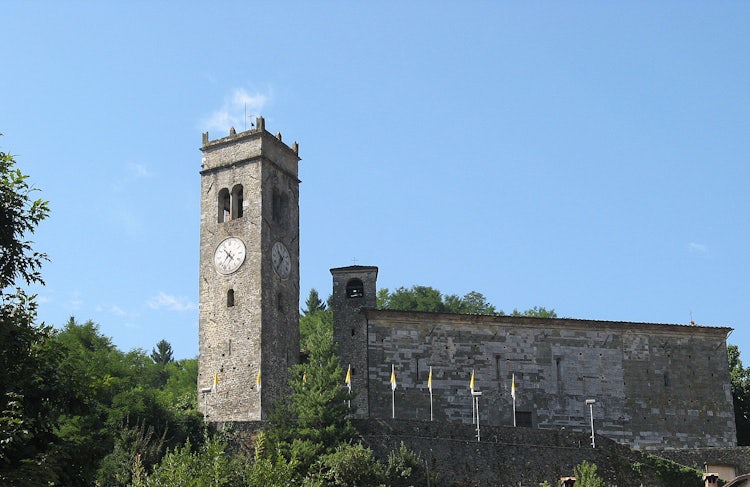
A Detour: From Small Towns to Natural Beauty
A Variation on a theme
Heading north you will be following the SP2, and for this detour, take the eastbound road marked SP39, which will actually make a circle and bring you back to the departure point without backtracking. The road SP39 up towards the following towns is not really for the faint of heart since it is narrow and very curvy both up and back. However, if you appreciate the wonders of Mother Nature, you will probably find this to be the highlight of your trip. Or you can skip these small towns and proceed with the northward trek (click here to skip the detour).
Grotta del Vento
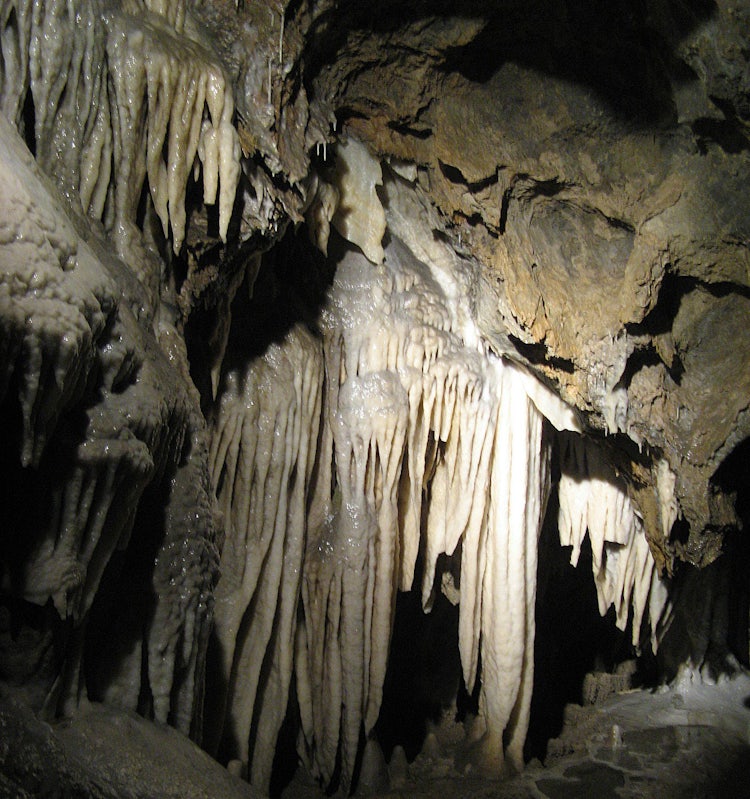
Winding back into the hills to the left of the river Serchio, you find Grotta del Vento. A rather recent discovery located over 500 meters above sea level which can be explored more in depth with the help of expert speleological guides. Though long remembered by the locals as a cool and refreshing niche to store food, its full extent was never really known. The howling sounds caused by the wind as it pushed through the tunnels made it an excellent place to play a game of truth or dare by the more courageous youngsters in the area.
The tunnels, holes, and galleries were created from rainwater and snowfall that penetrated the mountain as it trickled down into the valley. Since the water in this area was rich in carbon dioxide and thus acidic, it slowly melted the calcareous rock, giving birth to a large number of small tunnels that eventually gradually created the wonderland of stalactites and stalagmites, alabaster draperies, crystal-brimmed lakes, underground water rivers and bizarre forms of erosion.
Read more about the Grotta del Vento at our link.
Eremo di Calomini
The church Santa Maria and Martyrs was first mentioned in the early 1300's and it is well known even today as a site for the Marian cult. But it is not for this that we suggest a stop, but rather for the evocative architecture of the hermitage which is carved directly out of living stone, built to protect the very spot where the Virgin Mary appeared to a young shepherd girl in the mountains. During the summer the hermitage is open every day, meanwhile in other months only on Sundays, during the Mass. If you really want to visit inside, you should make arrangements with the pastor.
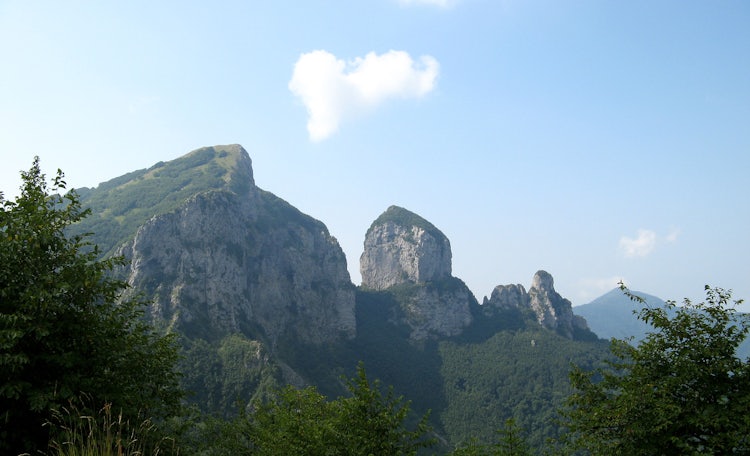
Vergemoli
In Vergemoli you will pass by the Church of Saints Quirico and Giuditta, dating back to the 10th century. This small town is well protected by the rocky walls of Pania della Croce (1,858 m.), Pania Secca (1709 m.) and Croce Mountain (1314 m.).
II Monte Forato
This is a day trip all on its own. It is formed by two peaks of similar altitude, connected by a natural arch which has given the group its name Monte Forato (meaning "Mountain with a hole in the middle"). The hole, nearly circular in shape, has a height of c. 12 m, while the arch itself is some 8 meters thick. The arch is so pronounced that it can be seen from both Versilia and Garfagnana valleys!
Read how to plan your hike to Monte Forato
At this point you will end the circular detour and join the SP2, heading north.
Barga
The city grew as a castle surrounded by a series of walls, and unfortunately, only two gates have survived the test of time (Porta Reale and Porta Macchiaia). The town was well known during the Middle Ages for the manufacture of silk threads which were exported to major centers such as Florence, it’s mills powered by the hydraulic power of the nearby creeks. In the Middle Ages, Lucca and Pisa battled frequently to conquer the wealthy town and the surrounding territory.
Take a walk in the old city center and you'll bump into old historical buildings like that of Palazzo Balduini, Palazzo Angeli Palazzo Pancrazi, and Palazzo Podestà just to mention a few - and churches like the Chiesa del Santissimo Crocifisso and Chiesa della Santissima Annunziata, home to prestigious paintings.This town has a rich calendar of events, and you are sure to find something to tempt you to stay a bit longer.
Read more about the quaint little town of Barga in our article.
Curious note: Barga is also the home to European sanctuary for Garden Gnomes (MALAG), so keep an eye out for this colorful ceramic statues
Castelnuovo di Garfagnana
The Rocca Ariostesca, or the fortress, dominates the main square Piazza Umberto I. Its name comes from Ludovico Ariosto, a poet, who governed the provinces within the Garfagnana from 1522-1525. Another site to visit is on the hillside above the city, which can be reached by following the Path of Ariosto or “la passeggiata degli innamorati” (Lover’s Lane).
Duke Alfonso II d'Este is responsible for the building of the “La Fortezza di Mont'Alfonso," which covers an area of about 60,000 square meters making it one of the largest historic sites in the valley. Using his skills in military strategy, it was built to be impregnable and inaccessible by the enemy. Legend tells us that the fortress is connected via a secret passage that led to the Rocca Ariostesca in Castelnuovo.
There are many good restaurants to check out at Castelnuovo and this is a perfect place to enjoy a lunch based on local specialties. Vecchio Mulino (Via Vittorio Emanuele, 12, 55032) is nestled in an almost forgotten little corner of town but promises abundant portions and genuine flavors. For a tasty treat then you will want to save the date for the first weekend of the month when they hold the Mercato Contadino, where you are sure to find a delicious selection of local cold cuts, cheeses, and other flavors.

Piazza al Serchio
The first traces of man suggest the possibility that this area was inhabited even before the Romans; however, the first concrete evidence is from the Longboard times. This town is a geographical point connecting the Garfagnana area with Emilia Romagna and the Lunigiana. There is a lovely humpbacked bridge (called "Ponte a Sella d'Asino" in Italian) called Ponte di San Michele, which is the only access to the antique borough.
Noteworthy are the naturally occurring stone peaks, many of which emerge out of the river Soraggio and S.Michele, called "doglioni". These curious forms are made of rocks that have a volcanic origin. As you enter the town from the direction of Lucca, there is a steam engine (Gruppo 940): this particular model was specifically built with a strong motor to enter into the steep Apennine mountains in central Italy. It stands as if ready to protect the small town and appears to explode out of a tunnel with the land formation doglioni behind it.
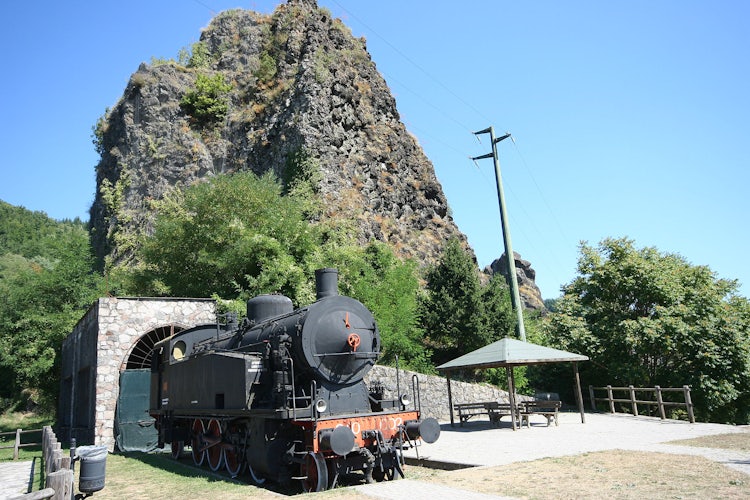
Castello Verrucola
This last stop is a bridge between two regions: Garfagnana and Lunigiana and not to be confused with Fortezza di Verrucole, found closer to Castelnuovo di Garfagnana.
The castle of Verrucola Bosorum (Verrucola de'Bosi), first mentioned by trusted sources in 1044, was a vassal of Countess Matilde of Canossa, a commanding female figure in history. In 1183 it fell into the hands of the Malaspina family, thanks to the Peace of Constance signed with Federico Barbarossa. However, in 1312 it became the center of the dispute between Spinetta Malaspina, called “Il Grande”, and Castruccio Castracani degli Antelminelli, Lucchese.
This constant turnover led to a bloody conflict which persisted for years and influenced many other smaller feuds in the area.
In 1418, Verrucola was the scene of a clamorous bloodbath, a conspiracy behind the marquis of Bartholomew Malaspina, who was shot dead along with his pregnant wife, his family and servants.Only the 20 month old Spinetta was saved
After its years of decline and damage from several earthquakes, a complete restoration was carried out by the current owner, the sculptor Pietro Cascella, re-establishing it as one of the most impressive fortified complexes between Garfagnana and Lunigiana. Formed of a square keep, and tall tower, a medieval bridge and two gates, it can be considered one of the best-preserved complexes between the Garfagnana and Lunigiana.

An Overview of the Garfagnana
This brief itinerary only touches a few of the many points of interest in this area. Though characterized by sparsely populated mountains, you will find several opportunities to wander off the main roads and discover small towns which still maintain much of their original architecture, and charm. As you reach the top of the itinerary, we suggest that you take a more direct and faster route back to Lucca by heading over to the coast and catching the E80 toll road just outside of Santo Stefano di Magra. Or you could call it a day, and then explore the wonders of Lunigiana or a day for your next day trip following the nearby "Strada del Vino" or wine roads.
